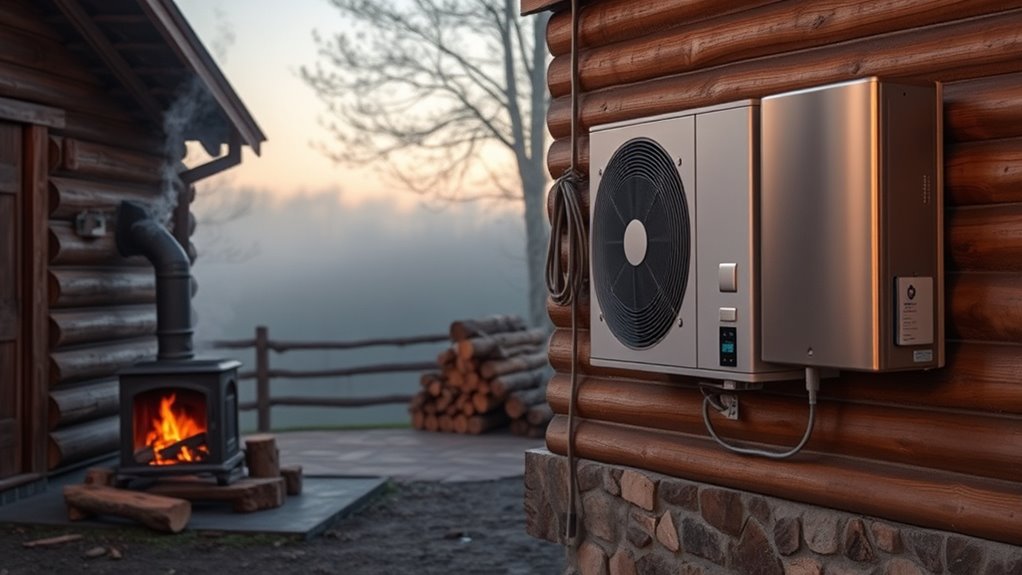When choosing between wood and electric heating, consider their environmental and cost differences. Wood is renewable and adds less CO2 if biomass is sourced responsibly, but it produces particulate pollution and has higher installation and maintenance costs. Electric heating has a lower upfront cost and minimal maintenance, but its environmental impact depends on how the electricity is generated—renewables make it cleaner. To find out which option best fits your budget and eco goals, keep exploring the details.
Key Takeaways
- Wood heating is renewable but has higher installation costs and produces particulate pollutants affecting air quality.
- Electric heating’s environmental impact depends on energy sources; renewable energy makes it cleaner and more sustainable.
- Electric systems generally have lower upfront costs and require less maintenance than wood heating systems.
- Long-term costs for wood heating include firewood expenses and chimney maintenance, while electric costs depend on electricity rates.
- Choosing between them involves balancing wood’s sustainability and higher installation costs against electric heating’s lower initial investment and cleaner profile with renewable energy.

Are you trying to decide between wood and electric heat for your home? Both options come with their own set of advantages and drawbacks, especially when it comes to environmental impact and installation costs. Understanding these factors will help you make a more informed choice aligned with your priorities and budget.
When considering environmental impact, wood heating is often viewed as more sustainable because it’s a renewable resource. If sourced responsibly, burning wood releases carbon dioxide that was absorbed by the trees during their growth, creating a relatively balanced cycle. However, it’s not entirely free of emissions; wood combustion can produce particulate matter and other pollutants that affect air quality. On the other hand, electric heat’s environmental footprint depends heavily on how the electricity is generated. If your power comes from coal or natural gas plants, it can have a significant carbon footprint. Conversely, if your electricity comes from renewable sources like wind or solar, electric heating can be a much cleaner option. So, your local energy mix plays a vital role in determining which choice is better for the environment.
Installation costs form another essential factor. Wood heating systems, such as stoves or fireplaces, typically require a higher upfront investment. You’ll need to purchase the unit itself, install a chimney or venting system, and ensure proper clearance and safety measures. These costs can add up quickly, especially if your home needs modifications to accommodate the system. Additionally, ongoing expenses—like buying and storing firewood—should be factored into your budget. Electric heating systems usually have lower initial costs since they require less complex installation. You might need to upgrade your wiring or add a dedicated circuit, but overall, these costs tend to be more manageable. Plus, electric systems often come with fewer maintenance requirements, which can save you money over time. For example, some home heating systems can incorporate energy-efficient technology that further reduces long-term expenses.
Frequently Asked Questions
How Does Local Climate Influence Heating Choice?
Your local climate greatly influences your heating choice because it affects climate adaptability and regional resource availability. In colder areas, wood might be more practical due to abundant forests, while electric heating works well in milder climates with reliable power. Consider how extreme temperatures and seasonal changes impact your needs. By understanding your region’s resources and climate, you can select the most efficient, cost-effective, and environmentally friendly heating option.
Are There Health Risks Associated With Wood or Electric Heating?
You should be aware that wood heating can pose health risks by reducing indoor air quality, releasing pollutants like particulate matter and volatile organic compounds that can irritate your lungs. Electric heating generally has fewer air quality concerns, but noise pollution from some electric units might be an issue. To protect your health, make certain proper ventilation with wood and choose quiet, efficient electric systems.
What Maintenance Costs Are Involved With Each Heating Type?
Ironically, maintenance costs are often underestimated. With wood heating, you’ll spend on fuel storage, chopping, and cleaning soot, plus replacing equipment as it wears out faster. Electric systems need little upkeep—just occasional inspections and replacing filters. Over time, electric equipment tends to have a longer lifespan, making maintenance cheaper. So, while wood seems cheaper initially, the ongoing costs and frequent repairs might surprise you.
How Do Subsidies or Incentives Affect Overall Costs?
Government incentives and subsidies markedly lower your overall costs for both wood and electric heating. When you take advantage of these programs, the subsidy impact reduces upfront expenses, making either option more affordable. For example, electric heat might qualify for energy efficiency rebates, while wood heating could benefit from renewable energy incentives. These financial benefits can make sustainable choices more accessible, helping you save money in the long run.
Can Hybrid Systems Optimize Both Wood and Electric Heating Benefits?
Yes, hybrid systems can optimize both wood and electric heating benefits. By combining renewable energy sources and focusing on appliance efficiency, you can reduce costs and carbon footprint. These systems adapt to weather conditions and energy prices, allowing you to switch seamlessly between wood and electric heating. This flexibility helps maximize efficiency while minimizing environmental impact, giving you a more sustainable and cost-effective way to heat your home.
Conclusion
Choosing between wood and electric heat is like steering a balancing act on a tightrope—you weigh the warmth against costs and environmental impact. Wood offers a cozy, renewable option but demands effort and emits more carbon. Electric heat is cleaner and hassle-free but can be pricier and less sustainable if the grid isn’t green. Ultimately, your decision shapes your home’s comfort and your planet’s future—so pick wisely, knowing every choice casts a ripple across our world.











